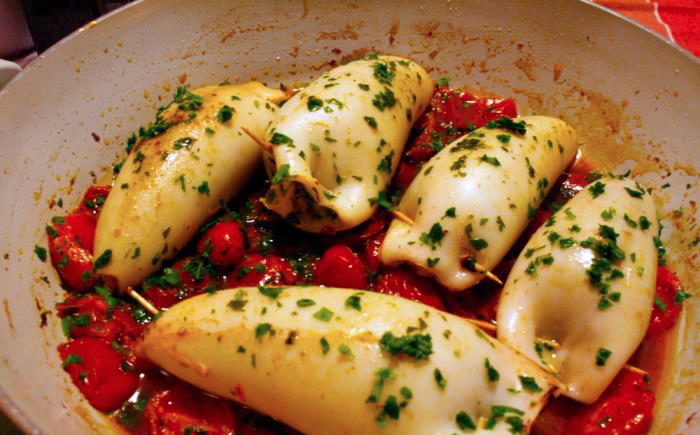Aeolian cuisine subtly unites many ingredients found in the wild, which are used to enhance everything from goat to grouper. The aromatic finocchio selvatico (wild fennel), ruchetta selvatica (wild arugula) and dente di leone (dandelion), are essential components in the recipes of the islands. These, along with mint, oregano, rosemary and basil round out the necessary list of herbs in the Aeolian pantry.
Capperi (capers) are grown on a number of the islands and as expected, find their way into many Aeolian recipes. Pomodorini pennuli (cherry tomatoes on the vine) are grown in abundance and add color and a tangy sweetness to salads and pasta, but it is seafood that is the staple of the Aeolian diet. Whether pan-fried, grilled, poached or broiled – it rarely needs embellishment other than a hint of herbs, a squeeze of lemon and a swirl of olive oil. Fresh fish is always paired with local wine, such as the Malvasia delle Isole Lipari, also known as the nectar of gods.
Mollusks are another favorite of the Aeolian table with calamari and its larger cousin, totano, also known as the European flying squid. Either stewed in a tomato-caper sauce or stuffed with a mixture of breadcrumbs, olives, capers, garlic and parsley, each is a welcomed addition to the table. Seppie (cuttlefish) are often stewed in their own ink and polpo (octopus) makes a mouthwatering salad when tossed with capers, lemon juice, olive oil and parsley.
One of the fruits of the islands is the Fichi d’India – the famous prickly pear. The name itself is interesting because it is not from India nor is it a fig. It was brought to Italy by Columbus and found the perfect growing environment in Sicily and in the Aeolian Islands. For centuries, it has been enjoyed for its juicy sweetness, also being transformed into preserves, juices, condiments, liqueur and even skincare products.
Calamari Ripieni alla Liparese
Stuffed Squid Lipari-style
Ingredients
- 12 medium squid
- 1 lb ripe cherry tomatoes
- 1 cup breadcrumbs
- 1 onion
- 1/4 cup capers
- 1/4 cup flat leaf parsley, finely chopped
- 1/4 cup chopped green Sicilian olives
- 1/4 cup grated pecorino cheese
- 6 basil leaves
- extra virgin olive oil
- freshly ground black pepper
- salt to taste
Preparation
Clean the squid by pulling the tentacles and head away from the body. Remove the mouth from the head at the base of the tentacles. Cut away the head between the tentacles and eyes and discard the mouth and head. Hold the body of the squid under cold running water, peel the outer skin, then squeeze out the insides and pull out the cartilage. Thoroughly rinse the inside of the hood and try not to puncture it.
Chop the tentacles and put them in a mixing bowl with the breadcrumbs, pecorino cheese, capers, green olives and parsley. Add salt and pepper to taste. Chop six cherry tomatoes and add them to the stuffing, then evenly mix the ingredients and fill each squid with the stuffing. Seal the open end of the squid with toothpicks and set aside.
Finely dice the onion and cut the remaining cherry tomatoes in half. Heat the olive oil in a large pan over medium-high flame and sauté the onions until they are transparent. Add the chopped tomatoes, salt and pepper to taste and cook for about 3 minutes. Lower the flame and add the squid and basil. Cover and simmer for 15 minutes or until the calamari is tender. Ladle the sauce onto a serving platter and arrange the squid on top to serve. If desired, toss the sauce with a long pasta, such as linguine. Slice the squid into three or four pieces and arrange them on top of the pasta.
Pasta with Aeolian Island Sauce
Ingredients
- 1 lb penne rigate
- 3 ½ oz capers
- 6 San Marzano tomatoes
- 1 clove of garlic
- 3 basil leaves
- 2 oz green olives
- 2 oz black olives
- 2 ½ tbsp Extra Virgin Olive Oil
- 1 pinch chili pepper powder
- 1 tsp fresh oregano, chopped
- salt to taste
Preparation
Wash, peel and seed the tomatoes; coarsely chop and set aside. De-salt the capers by passing three or four times under cold running water. After lightly squeezing the capers dry, mince along with the pitted olives. Place a pan over a medium flame. Add the olive oil and once hot, add the peeled garlic. Cook the garlic until golden and then remove from the pan. Add the mixture of chopped olives and capers and cook for 2 minutes. Add the tomatoes and cook for 10 minutes, stirring occasionally.
Tear the basil leaves and add to the sauce along with the chopped oregano and a pinch of chili pepper. Adjust the salt to taste. Meanwhile cook the pasta in a large pot of boiling, salted water. Once the pasta is al dente, drain, toss with the sauce and serve with a drizzle of olive oil.
Caponata
Caponata is one of the most popular dishes of the Aeolian Islands. Whether as an accompaniment to grilled fish or as an appetizer on crusty bread, it is a delicious addition to any meal. Once prepared, you can cover and chill for up to two days before serving.
Ingredients
- 5 tbsp olive oil
- 1 1-½ pound eggplant, unpeeled, cut into ½ inch cubes
- 1 medium onion, cubed
- 4 large garlic cloves, chopped
- 1 15 oz can diced tomatoes
- 3 tbsp red wine vinegar
- 12 green olives, pitted and coarsely chopped
- 2 tbsp drained capers
- 1/3 cup chopped fresh basil
- 1 tbsp flat leaf parsley, minced
- toasted pignoli nuts
Preparation
Toast pignoli nuts in the oven at 325°F until golden, 5-6 minutes. Heat the olive oil in heavy large pot over a medium flame. Add the eggplant, onion and garlic. Sauté until the eggplant is soft and brown, about 15 minutes. Add the diced tomatoes with juice, red wine vinegar, chopped olives and drained capers. Cover and simmer until the eggplant and onion are very tender, stirring occasionally – about 12 minutes. Season the caponata to taste with salt and pepper. Mix in the fresh basil and then transfer the caponata to a serving bowl. Sprinkle with toasted pignoli nuts and parsley. Caponata can be served warm, at room temperature or cold.





